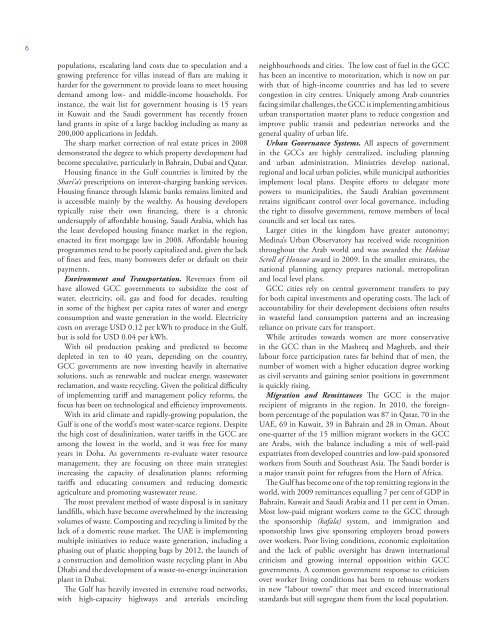The state of Arab Cities 2012/2013
The state of Arab Cities 2012/2013
The state of Arab Cities 2012/2013
Create successful ePaper yourself
Turn your PDF publications into a flip-book with our unique Google optimized e-Paper software.
6populations, escalating land costs due to speculation and agrowing preference for villas instead <strong>of</strong> flats are making itharder for the government to provide loans to meet housingdemand among low- and middle-income households. Forinstance, the wait list for government housing is 15 yearsin Kuwait and the Saudi government has recently frozenland grants in spite <strong>of</strong> a large backlog including as many as200,000 applications in Jeddah.<strong>The</strong> sharp market correction <strong>of</strong> real e<strong>state</strong> prices in 2008demonstrated the degree to which property development hadbecome speculative, particularly in Bahrain, Dubai and Qatar.Housing finance in the Gulf countries is limited by theShari’a’s prescriptions on interest-charging banking services.Housing finance through Islamic banks remains limited andis accessible mainly by the wealthy. As housing developerstypically raise their own financing, there is a chronicundersupply <strong>of</strong> affordable housing. Saudi <strong>Arab</strong>ia, which hasthe least developed housing finance market in the region,enacted its first mortgage law in 2008. Affordable housingprogrammes tend to be poorly capitalized and, given the lack<strong>of</strong> fines and fees, many borrowers defer or default on theirpayments.Environment and Transportation. Revenues from oilhave allowed GCC governments to subsidize the cost <strong>of</strong>water, electricity, oil, gas and food for decades, resultingin some <strong>of</strong> the highest per capita rates <strong>of</strong> water and energyconsumption and waste generation in the world. Electricitycosts on average USD 0.12 per kWh to produce in the Gulf,but is sold for USD 0.04 per kWh.With oil production peaking and predicted to becomedepleted in ten to 40 years, depending on the country,GCC governments are now investing heavily in alternativesolutions, such as renewable and nuclear energy, wastewaterreclamation, and waste recycling. Given the political difficulty<strong>of</strong> implementing tariff and management policy reforms, thefocus has been on technological and efficiency improvements.With its arid climate and rapidly-growing population, theGulf is one <strong>of</strong> the world’s most water-scarce regions. Despitethe high cost <strong>of</strong> desalinization, water tariffs in the GCC areamong the lowest in the world, and it was free for manyyears in Doha. As governments re-evaluate water resourcemanagement, they are focusing on three main strategies:increasing the capacity <strong>of</strong> desalination plants; reformingtariffs and educating consumers and reducing domesticagriculture and promoting wastewater reuse.<strong>The</strong> most prevalent method <strong>of</strong> waste disposal is in sanitarylandfills, which have become overwhelmed by the increasingvolumes <strong>of</strong> waste. Composting and recycling is limited by thelack <strong>of</strong> a domestic reuse market. <strong>The</strong> UAE is implementingmultiple initiatives to reduce waste generation, including aphasing out <strong>of</strong> plastic shopping bags by <strong>2012</strong>, the launch <strong>of</strong>a construction and demolition waste recycling plant in AbuDhabi and the development <strong>of</strong> a waste-to-energy incinerationplant in Dubai.<strong>The</strong> Gulf has heavily invested in extensive road networks,with high-capacity highways and arterials encirclingneighbourhoods and cities. <strong>The</strong> low cost <strong>of</strong> fuel in the GCChas been an incentive to motorization, which is now on parwith that <strong>of</strong> high-income countries and has led to severecongestion in city centres. Uniquely among <strong>Arab</strong> countriesfacing similar challenges, the GCC is implementing ambitiousurban transportation master plans to reduce congestion andimprove public transit and pedestrian networks and thegeneral quality <strong>of</strong> urban life.Urban Governance Systems. All aspects <strong>of</strong> governmentin the GCCs are highly centralized, including planningand urban administration. Ministries develop national,regional and local urban policies, while municipal authoritiesimplement local plans. Despite efforts to delegate morepowers to municipalities, the Saudi <strong>Arab</strong>ian governmentretains significant control over local governance, includingthe right to dissolve government, remove members <strong>of</strong> localcouncils and set local tax rates.Larger cities in the kingdom have greater autonomy;Medina’s Urban Observatory has received wide recognitionthroughout the <strong>Arab</strong> world and was awarded the HabitatScroll <strong>of</strong> Honour award in 2009. In the smaller emirates, thenational planning agency prepares national, metropolitanand local level plans.GCC cities rely on central government transfers to payfor both capital investments and operating costs. <strong>The</strong> lack <strong>of</strong>accountability for their development decisions <strong>of</strong>ten resultsin wasteful land consumption patterns and an increasingreliance on private cars for transport.While attitudes towards women are more conservativein the GCC than in the Mashreq and Maghreb, and theirlabour force participation rates far behind that <strong>of</strong> men, thenumber <strong>of</strong> women with a higher education degree workingas civil servants and gaining senior positions in governmentis quickly rising.Migration and Remittances <strong>The</strong> GCC is the majorrecipient <strong>of</strong> migrants in the region. In 2010, the foreignbornpercentage <strong>of</strong> the population was 87 in Qatar, 70 in theUAE, 69 in Kuwait, 39 in Bahrain and 28 in Oman. Aboutone-quarter <strong>of</strong> the 15 million migrant workers in the GCCare <strong>Arab</strong>s, with the balance including a mix <strong>of</strong> well-paidexpatriates from developed countries and low-paid sponsoredworkers from South and Southeast Asia. <strong>The</strong> Saudi border isa major transit point for refugees from the Horn <strong>of</strong> Africa.<strong>The</strong> Gulf has become one <strong>of</strong> the top remitting regions in theworld, with 2009 remittances equalling 7 per cent <strong>of</strong> GDP inBahrain, Kuwait and Saudi <strong>Arab</strong>ia and 11 per cent in Oman.Most low-paid migrant workers come to the GCC throughthe sponsorship (kafala) system, and immigration andsponsorship laws give sponsoring employers broad powersover workers. Poor living conditions, economic exploitationand the lack <strong>of</strong> public oversight has drawn internationalcriticism and growing internal opposition within GCCgovernments. A common government response to criticismover worker living conditions has been to rehouse workersin new “labour towns” that meet and exceed internationalstandards but still segregate them from the local population.


